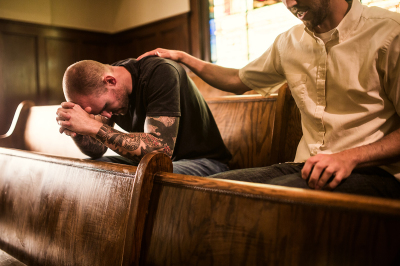Developing a culture of prayer (book excerpt)

While pastoring, I developed a tradition of praying for an hour each Saturday night. I would walk to the church, and then pace the empty sanctuary praying for the next day’s service and the men and women who would be in attendance. The truth is, I also prayed for myself. I prayed that God would do in those services what I knew I was not capable of doing by my own talent or ability. I was desperate for God to move, and I wasn’t sure what else to do but pray.
One Saturday night, I looked up, and a man from the congregation was standing at the back of the sanctuary watching me.
“What are you doing?” he asked.
“Praying,” I responded.
He looked at me for a moment and asked, “Can I join you?”
It wasn’t a program. It wasn’t even really a prayer service. It wasn’t part of some strategy I had outlined for cultivating a movement of prayer in our church. But we were intentional. Every Saturday, we showed up with no other agenda than to pray. Eventually, a few others joined us. Word began to spread, and I made it official. Before long there were sometimes as many as one hundred of us praying together. It was an altar, a place where we met with God.
We often experienced powerful moves of the Spirit. While praying, someone would feel drawn to a particular seat. They would feel an urgency to pray over that place and the person who would sit there the next day, sensing that God had plans for that person. As Sunday came, we all witnessed hands rise for salvation from the very seats where they had sensed the Spirit’s call to pray. We all sensed that our prayers were a part of something bigger than Saturday nights. Our passion for prayer and for the altar was growing.
Looking back, something in our congregation changed through those Saturday nights, something I was leading without realizing what it was. I now look back and recognize how those Saturday prayer meetings began to change the people in my church, and how they began to infuse our church with a new culture of prayer.
There is so much advice and there are so many techniques for how to change the culture of a church, but it isn’t as complicated as it may sometimes seem. Culture is simply a set of shared values. Culture forms as a group of people begin to value similar things. Whatever we value most is what defines our culture. That is not hard to understand, but it can be extremely difficult to change.
Certainly, part of the challenge is getting people to value something new. But the real challenge of changing a church’s culture is getting people to be honest about what they really do value. Most of us who have followed Jesus for any amount of time know the things we should value. But knowing something is valuable doesn’t mean we actually value it. We may even all agree that something is valuable, but that does not mean that we, as a church, truly value it. We can know the value of a piece of art, a luxury car, or dinner at a five-star restaurant, but that doesn’t mean we want it or are willing to pay for it. Knowing that it is valuable does not mean that we personally value it.
Prayer is like that. We know prayer is valuable. We know that it is a vital part of any believer’s life, and we know that Jesus valued it. But we can know prayer is valuable without valuing it ourselves. I have never been in a church that didn’t think prayer was valuable, but I have been in very few churches where prayer was a shared value.
That is all culture is. A culture of prayer simply means that your church both knows the value of prayer and personally values it themselves. To change the culture of your church, to create a new culture of prayer, you need only move prayer from a thing that is valuable to a thing your church actually values. It must be made one of the main things on the calendar and in the practice of leadership before it will become a high value in the culture of the church.
I pose a simple question to test what your church currently values. What is the first thing you do when there is a need? Do you hold an emergency meeting? Do you start raising funds? Do you turn to your favorite online resource for advice? When the early Church found themselves facing a need, the first thing they did was pray. It is the pattern repeated again and again in the Book of Acts. The early Church constantly gathered to pray. It was the first thing they did. It was the thing they valued most. It was their culture.
If you are going to call your church to prayer, if you are going to create a culture of prayer, if you are going to help the men and women in your church live in the throne room of God, it is going to take honesty about what you actually value as a community, and it is going to take intentionality to build new altars of prayer.
As our church began to grow in prayer, I became increasingly intentional about working prayer into every part of our time together and into our leadership development. We simplified our board’s responsibilities and met for no other reason than prayer. The staff began to prioritize praying together each week, and we challenged one another to press deeper and expect more from our personal prayers. I didn’t have the language for it at the time, but we were intentionally constructing altars. We were building places in which we could “approach God’s throne of grace with confidence, so that we may receive mercy and find grace to help us in our time of need” (Hebrews 4:16). We were learning to approach God’s throne of grace with confidence because we needed mercy and grace to help us in our times of need.
We were crafting a new culture based on a valuable thing becoming the thing we valued most. It is possible for your church, too. I want to help you construct altars of your own, places where you can encounter God and connect heaven and earth, and places that will change the culture of your church.
Adapted from In Jesus Name by Rick DuBose, provided by Chosen Books, a division of Baker Publishing Group. Copyright 2023. Used by permission.
Rick DuBose is the assistant general superintendent of the Assemblies of God and a member of the executive leadership team. The author of The Church That Works and In Jesus’ Name, DuBose is a respected pastor and has served the Assemblies of God in various local and national leadership positions for more than two decades. He and his wife, Rita, have three adult children and eight grandsons and make their home in Springfield, Missouri.



























